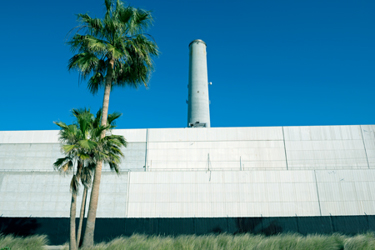Thirst For Water: How The Nation's Largest Desalination Plant Is Generating Change
By Vic Bianes and Jeremy Crutchfield

Nearly a decade on, the Carlsbad Desalination Plant is a model of success not only for seawater reverse osmosis but also for visionary problem-solving.
When the nation’s largest desalination plant opened in Carlsbad, California, in 2015, people across the country were watching to see how it increased water supplies as groundwater dwindled, reservoirs dried up, and drought ravaged the Golden State.
Nearly 10 years later, the plant has demonstrated how seawater desalination can play a pivotal role in achieving water security. Dependent on the Colorado River and State Water Project, California found itself watching water supplies reach dangerously low levels, forcing water agencies statewide to look beyond the usual solutions and tap into new opportunities.
With a near-endless supply of water from the Pacific Ocean, the Claude “Bud” Lewis Carlsbad Desalination Plant processes up to 100 million gallons of water per day. The water is filtered through gravel, sand, and other compounds to reduce particulates before it goes through reverse osmosis (RO) filtration. Approximately half of the saltwater taken into the plant is converted into potable water — enough to supply about 400,000 people daily — while the remaining water is discharged as brine.
The plant’s success has fostered larger discussions about water supply and water management in the era of climate change.
Private-Public Partnerships
Water supply is not an issue that affects just municipalities or public works agencies; its reach is far and broad, impacting residents, businesses, agriculture, and manufacturing operations. In San Diego County, regional water officials knew they couldn’t go it alone. Businesses and residents were critical to ensuring the desalination plant would move from concept to commercialization.
Together with Poseidon Water and the Water Authority, a blue-ribbon panel of public agencies, residents, and stakeholders was engaged to educate and gain support for the project, which ultimately led to successfully obtaining required permits. While development costs and associated risks were shouldered by private enterprise — in this case, Poseidon and its investors — the Water Authority and its member agencies walked side-by-side every step of the way. With a thoughtfully developed plan, operational strategy, and design, the project became a gold standard among seawater desalination plants around the world.
Economics At Play
In an era when “do-more-with-less” has become a way of life, building and operating seawater desalination plants can be overwhelming. Although technical and scientific advancements have made desalination plants more efficient, they are still expensive to build and operate. That means water generated also costs more than water from other sources, including groundwater and the Colorado River. However, the costs of seawater desalination are comparable to costs of other next-generation sources such as potable reuse — and those are the only new water resources available in many areas.
Given the scarcity of new supplies, the price of desalination is reasonable. Bringing the new water supply into homes through the Carlsbad plant increased the average monthly water bill in the San Diego region by just $5 per household — or about the cost of a cup of coffee.
Measuring Environmental Impact
California has some of the strictest environmental regulations in the nation. With requirements on design and operation, the Carlsbad plant continually monitors water coming into the system, as well as the brine discharge.
Studies, along with continual monitoring, have demonstrated seawater desalination can be performed in an environmentally sensitive way without causing harm to the aquatic ecosystem.
Trailblazing
The Carlsbad Desalination Plant has also been a beacon for several other projects that are at various stages of development in California.
Last November, state officials approved a desalination plant along the state’s central coast. There is relief in sight as the California Coastal Commission voted to approve a permit for the California American Water Co. to draw water from the coast of Marina, CA, to supply a private plant in Monterey County. Under the plan, the new water desalination plant would boost future water supplies in drought-stricken Monterey County.
But perhaps the most surprising desalination project comes from the Sonoran Desert. As part of an ambitious plan, Arizona officials recently voted to evaluate the prospects of creating a desalination plant on the Gulf of California. The goal would be to pipe water from the Sea of Cortez near Puerto Peñasco, Mexico, to Arizona, while allowing Mexico to use water generated by the plant in exchange for a share of the country’s water sourced from the Colorado River.
Critical Conversations
Water supply will continue to be complex and contentious, especially across the western U.S., as drought, climate change, and diminishing groundwater supplies upend historical norms.
But given improvements in technology — as well as the growing need to diversify water supply options — desalination is becoming an increasingly important source of fresh water. Innovation is driving costs down to the point where desalination is an economically viable solution for alternative water supplies.
Similarly, legislative initiatives are receiving greater attention for their focus on alleviating pressure and finding practical solutions for water supply reliability. Public utilities, including the American Public Works Association, are driving forward the principle of responsible water use beyond conserving and recycling to innovating and responsibly pushing the envelope when it comes to ensuring this valuable commodity is available for generations to come.
 About The Authors
About The Authors
Vic Bianes is an American Public Works Association national board technical director for fleet and facilities and grounds. He is a registered engineer and currently works for Kleinfelder Engineering as a major client manager. In 2018, he served as a board director for the County Water Authority and, in 2005, as the engineering design section manager for the County Water Authority.
 Jeremy Crutchfield is water resources manager at San Diego County Water Authority.
Jeremy Crutchfield is water resources manager at San Diego County Water Authority.
Learn more about the American Public Works Association’s water priorities at apwa.net.
